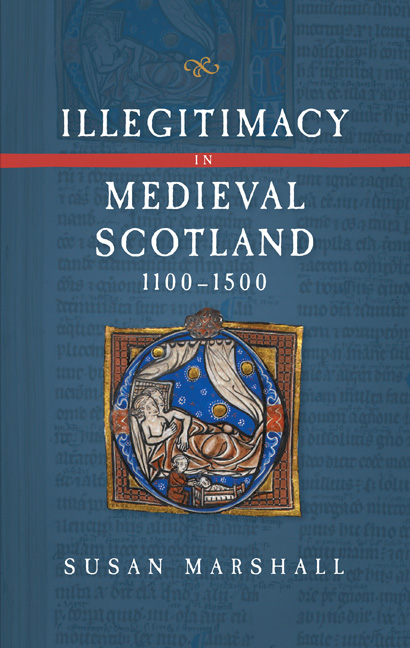Book contents
- Frontmatter
- Dedication
- Contents
- List of Tables
- Preface
- Acknowledgements
- Abbreviations
- Introduction
- 1 Church law and Scottish Families
- 2 Illegitimacy and Inheritance
- 3 Illegitimacy and Royal Succession I: Before the Great Cause
- 4 Illegitimacy and Royal Succession II: from the Great Cause to James I
- 5 Wives, Daughters, and Sisters
- 6 Church Careers and Sacrilegious Bastards
- 7 Illegitimacy in Political Life
- Conclusion
- Appendix I Scottish kings and their illegitimate offspring
- Appendix II Illegitimate sons of Scottish kings
- Timeline of key events
- Bibliography
- Index
1 - Church law and Scottish Families
Published online by Cambridge University Press: 26 March 2021
- Frontmatter
- Dedication
- Contents
- List of Tables
- Preface
- Acknowledgements
- Abbreviations
- Introduction
- 1 Church law and Scottish Families
- 2 Illegitimacy and Inheritance
- 3 Illegitimacy and Royal Succession I: Before the Great Cause
- 4 Illegitimacy and Royal Succession II: from the Great Cause to James I
- 5 Wives, Daughters, and Sisters
- 6 Church Careers and Sacrilegious Bastards
- 7 Illegitimacy in Political Life
- Conclusion
- Appendix I Scottish kings and their illegitimate offspring
- Appendix II Illegitimate sons of Scottish kings
- Timeline of key events
- Bibliography
- Index
Summary
For [quhay-sa] falt has in his natiuitie,
In his conditioun fa[l]tles sal nocht be
During the twelfth century the Church succeeded in claiming jurisdiction over marriage and established a body of canon law, further refined in the thirteenth century, setting out rules for what constituted valid marriage. Determination of legitimacy was also the province of the Church, since it depended on determination of marital status. The law of the Church came to be collected in the Corpus Iuris Canonici (c. 1586). Its constituent elements include the work known as Gratian's Decretum (c. 1140) which set out important principles concerning lawful marriage and discussed various kinds of illegal relationship, but had relatively little to say about illegitimacy; the Liber Extra (1234), which examined both marriage and illegitimacy in more detail, especially the circumstances in which offspring were and were not legitimate; and the Liber Sextus (1298), a compilation of decretals produced under the aegis of Pope Boniface VIII intended to supplement the Liber Extra.
Notwithstanding St Paul's judgement that marriage existed as a concession to human weakness and was inferior to celibacy, the Church supported marriage both in principle and in practice, and this was reflected in its laws. By the end of the eleventh century, the Church had come to see marriage as something exclusively for the laity, but a vocation nonetheless, a way of life that had its own place in the divine order. In its legal judgements, the Church sought to uphold the principle of favor maritalis, a bias in favour of endorsing the marriage wherever it was feasible to do so, and exercised a similar bias in respect of offspring, who benefited from a presumption of legitimacy.
The Church courts
Ecclesiastical courts were organised on a diocesan basis and each was presided over by an ‘official’, the chief legal officer of the bishop, assisted where required by other legal officers called commissaries. In large dioceses, such as Glasgow, where the volume of business in the courts was great, a commissary general might act as a deputy to the official.
- Type
- Chapter
- Information
- Illegitimacy in Medieval Scotland1100-1500, pp. 7 - 28Publisher: Boydell & BrewerPrint publication year: 2021



